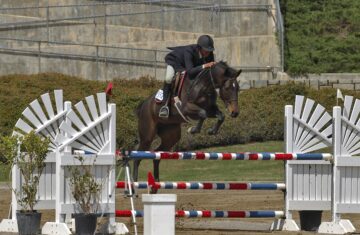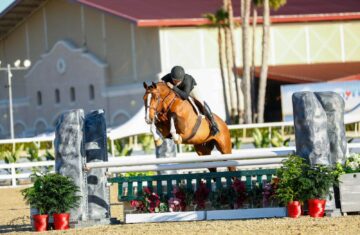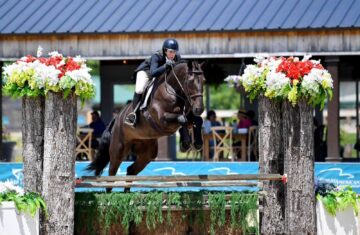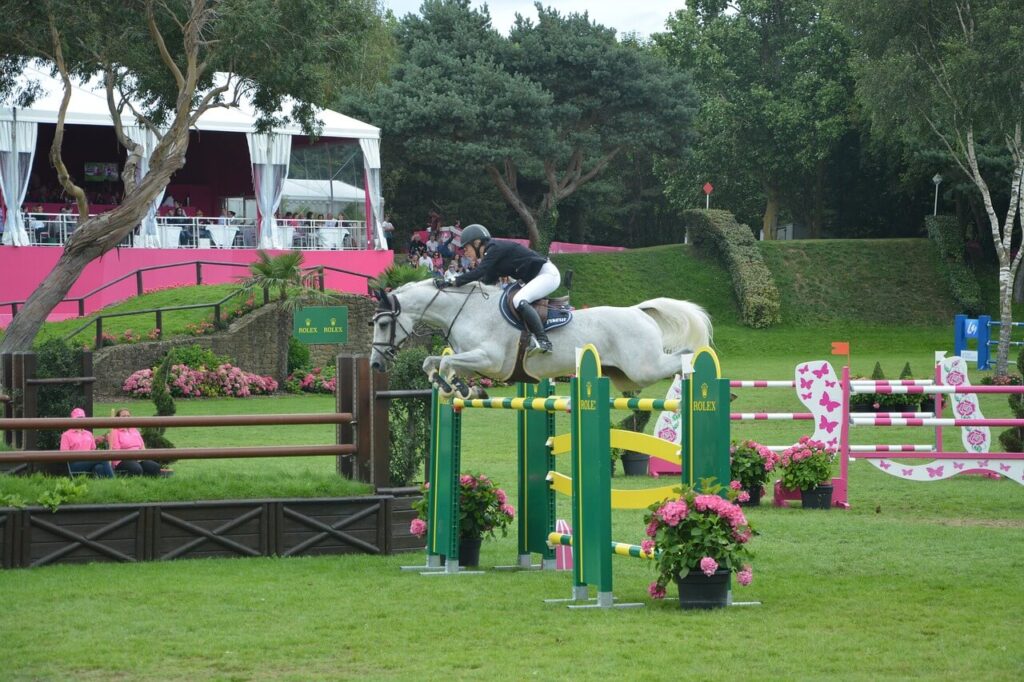Hyperion Stud
- 2 months ago
- USA
- Horses for sale
Peter Berkers Sporthorses
- 2 months ago
- Netherlands
- Horses for sale
Argento Equestrian
- 3 months ago
- Great Britain
- Horses for sale
This is only a selection of ads. Go to our search page to find more ads.
The Ultimate Guide to Show Jumping Horses: Understanding the Traits, Training, and Competitions
Show jumping is one of the most exciting equestrian disciplines, combining athleticism, speed, and precision. A show jumping horse must possess extraordinary qualities to clear obstacles while maintaining speed and agility. In this comprehensive guide, we will explore the characteristics of top show jumping horses, the breeds that excel in this sport, how to train a horse for show jumping, and what to look for when selecting a show jumping horse.
What is a Show Jumping Horse?
A show jumping horse is trained specifically for the sport of show jumping, where horse and rider navigate a course filled with fences, walls, and other obstacles. The goal is to complete the course as quickly and cleanly as possible, with no faults for knocking down jumps or exceeding the time limit. Show jumping requires horses to have a unique combination of power, agility, and carefulness, making them some of the most versatile athletes in the equine world.
Key Characteristics of a Show Jumping Horse
Not every horse can become a successful show jumper. Horses that excel in this sport need certain physical and mental qualities. Here are the key characteristics that define a top show jumping horse:
Powerful Hindquarters: Jumping over high fences requires explosive strength, particularly in the hindquarters. A show jumping horse needs a strong and muscular build in the back and legs to propel itself over jumps effortlessly.
Athleticism and Agility: Show jumping courses are complex, with sharp turns and varying heights of obstacles. The best show jumpers must be agile enough to make quick turns while maintaining balance. They also need to be fast and nimble, as speed is a crucial factor in many competitions.
Good Conformation: Conformation refers to the horse’s overall physical structure. A show jumper should have a well-balanced body with straight legs, a strong back, and sloping shoulders, which provide the flexibility needed to clear obstacles. Horses with good conformation are less prone to injury and can handle the physical demands of the sport better.
Bold and Brave Temperament: Show jumping horses must be brave, willing to face obstacles without hesitation. A timid or easily spooked horse may struggle in show jumping due to the intensity of the sport. Confidence, coupled with a strong work ethic, is essential for a successful show jumping horse.
Carefulness: The ability to jump high is not enough in show jumping. Horses must also be careful and precise to avoid knocking down rails. A careful horse will naturally lift its legs high enough to clear obstacles without hitting them.
Endurance and Stamina: Show jumping horses often participate in multiple rounds during a single competition, which can be both physically and mentally exhausting. Endurance is key for maintaining performance throughout the competition. The horse must be in excellent physical condition to maintain energy levels from start to finish.
Best Breeds for Show Jumping
Although many breeds can participate in show jumping, certain horse breeds are especially well-suited for the sport. Here are some of the most popular and successful breeds used in show jumping:
Warmbloods: Warmblood breeds like the Dutch Warmblood, Holsteiner, Hanoverian, and Belgian Warmblood dominate the show jumping world. These horses are known for their strength, size, and exceptional jumping ability. Warmbloods are carefully bred for performance, making them top choices for competitive jumping.
Thoroughbreds: Known for their speed and stamina, Thoroughbreds can also excel in show jumping, particularly at lower levels. While they might not have the same power as Warmbloods, their agility and determination often allow them to perform well in fast-paced competitions.
Irish Sport Horses: The Irish Sport Horse is a cross between the Irish Draught and Thoroughbred, combining the best traits of both breeds. These horses are strong, athletic, and highly versatile, making them ideal for both show jumping and eventing.
Selle Français: The Selle Français breed originates from France and has a long history of success in international show jumping. Known for their powerful hindquarters, balanced conformation, and exceptional jumping ability, they are popular choices for top riders.
Oldenburg: The Oldenburg horse is another Warmblood breed known for its large frame, athleticism, and excellent temperament. These horses are strong jumpers with a natural ability to clear high fences with ease.
Anglo-Arabians: A cross between the Thoroughbred and Arabian, the Anglo-Arabian is a lighter and more agile breed that excels in speed and stamina. Their boldness and endurance make them good candidates for show jumping, especially for riders seeking a more sensitive and responsive horse.
Training a Show Jumping Horse
Training a horse for show jumping is a long and structured process. Horses must learn not only how to jump but also how to navigate complex courses with speed and precision. Here’s a breakdown of the key stages of show jumping training:
Foundation Training: Every show jumping horse starts with basic groundwork, including halter training, leading, and basic obedience. It’s important for the horse to develop trust and respect for the rider, as well as to understand basic aids such as stopping, turning, and moving forward.
Flatwork: Before a horse ever begins jumping, flatwork (dressage training) is essential. This involves teaching the horse to move correctly under saddle, developing balance, rhythm, and flexibility. Flatwork helps build the horse’s core strength and ensures that the horse is responsive to the rider’s aids. Lateral movements, transitions, and bending exercises are important to build control and suppleness.
Introduction to Jumping: Once a horse has mastered the basics of flatwork, it’s time to introduce small jumps. Cavaletti (small poles on the ground) and low cross-rails are used to teach the horse how to approach and clear obstacles. The horse learns how to adjust its stride and where to place its feet.
Progression to Higher Jumps: As the horse becomes more confident and capable, the height of the jumps is gradually increased. Training focuses on teaching the horse to judge distances between jumps and to maintain balance and speed. Riders must also teach the horse to collect itself before jumping and extend its stride when necessary.
Course Training: Once the horse is comfortable with individual jumps, it’s time to practice navigating full courses. These courses vary in design, with combinations of verticals, oxers, and other obstacles. Horses learn to turn sharply, adjust their pace between jumps, and respond quickly to rider aids.
Advanced Techniques: At higher levels of show jumping, horses are taught more complex techniques like jumping combinations (multiple jumps in quick succession) and negotiating difficult turns and distances. The horse also learns to jump from various angles and approaches to handle the technical demands of advanced competitions.
Show Jumping Competitions and Scoring
In show jumping competitions, the goal is to complete a course of obstacles in the fastest time without faults. Faults are penalties given for knocking down rails, refusing a jump, or exceeding the time limit. In many competitions, horses and riders may face jump-offs, where they compete again in a shorter course to break ties.
The height and complexity of the jumps increase with the level of competition. In international competitions, such as FEI World Cup events and the Olympic Games, courses are designed to test the horse’s jumping ability, speed, and endurance at the highest level. Show jumping classes are divided by skill levels, age, and experience, ensuring fair competition for all riders and horses.
How to Choose the Right Show Jumping Horse
Choosing the right show jumping horse is a significant decision that depends on your level of experience, goals, and budget. Here are some key factors to consider when selecting a show jumper:
Experience: For beginners or intermediate riders, it’s wise to choose a horse that has already been trained in show jumping. An experienced horse will help build confidence and provide a more forgiving learning curve.
Age and Health: Ideally, look for a horse that is in its prime age for jumping (around 6-10 years old). Be sure to check the horse’s health and soundness, as injuries or poor conformation can limit jumping potential.
Temperament: A good show jumping horse should be brave, confident, and willing to work with the rider. Look for a horse that has a calm yet bold temperament, essential for tackling challenging courses.
Training Potential: If you are more experienced and looking to develop a younger horse, consider its potential for training. A young, athletic horse with the right traits can become a top-level jumper with the proper guidance.
Consult a Trainer: Always seek professional advice from a show jumping trainer when selecting a horse. Their expertise can help you find a horse that matches your skill level and long-term goals.
Conclusion
Show jumping horses are remarkable athletes that require a unique blend of physical ability, mental fortitude, and careful training. Whether you’re just starting in the sport or aiming for elite competitions, choosing the right show jumping horse and training them properly is key to success. With the right preparation, both horse and rider can enjoy the thrill and challenge of show jumping, competing at the highest levels with precision and speed.
Show jumping horses for sale Europe
Show jumping horses for sale internationally
Horses for sale Czech Republic





